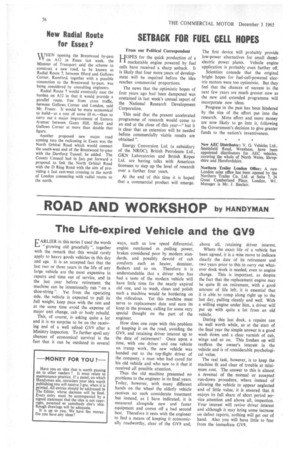ROAD AND WORKSHOP by HANDYMAN
Page 58

If you've noticed an error in this article please click here to report it so we can fix it.
The Life-expired Vehicle and the GV9
ARL1ER in this series I used the words "growing old gracefully ", together with the remark that this would rarely apply to heavy goods vehicles in this day and age. It is an accepted fact that the last two or three years in the life of any large vehicle are the most expensive in repairs and time out of service, and in the last year before retirement the machine can be intentionally run "on a shoe-string ". Yet from the operating side, the vehicle is expected to pull its full weight, keep pace with the rest and at the same time avoid the expense of major unit change, cab or body rebuild. This, of course, is asking quite a lot and it is no surprise to be on the receiving end of a well edited 0V9 after a Ministry inspection. To further spoil any chances of economical survival is the fact that it can be outdated in several
ways, such as low speed differential, engine outclassed in pulling power, brakes considered poor by modern standards, and possibly devoid of cab comforts such as heater, demister, flashers and so on. Therefore it is understandable that a driver who has had a taste of the modern vehicle will have little time for the nearly expired old one, and to wash, clean and polish such a machine would be bordering on the ridiculous. Yet this machine must serve to replacement date and earn its keep in the process, calling for some very special thought on the part of the engineer.
How does one cope with this problem of keeping it on the road, avoiding the GV9, and retaining driver interest up to the date of retirement? Once upon a time, with one driver and one vehicle on tramp work, the new vehicle was handed out to the top-flight driver of the .company, a man who had cared for his old vehicle and who saw to it that it received all possible attention.
Thus the old machine presented no problems to the engineer in its final years. Today, however, with many different hands on the wheel the elderly vehicle receives no such considerate treatment but instead, as I have indicated, it is measured alongside new and faster equipment and comes off a bad second best. Therefore it rests with the engineer to find a means of keeping it economically roadworthy, clear of the GV9 and, above all, retaining driver interest.
Where the exact life of a vehicle has been agreed, it is a wise move to indicate clearly the date of its retirement and two years prior to this to carry out whatever dock work is needed, even to engine change. This is important, as despite the fact that the replacement engine may be quite fit on retirement, with a good amount of life left, it is essential that it is able to romp along right up to the last day, pulling cleanly and well. With a willing engine under him, a driver will put up with quite a lot from an old vehicle.
During this last dock, a repaint can be well worth while, as at the start of the final year the simple answer is a good wash down and a clear. varnish of cab, wings and so on, This freshen up will reaffirm the owner's interek in the vehicle and is of considerable psychological value.
The real task, however, is to keep the machine fit and clear of trouble at minimum cost. The answer to this is almost a reversal of the normal or accepted run-down procedure, where instead of allowing the vehicle to appear neglected and of little value, it is ensured that it enjoys its full share of short period service attention and above all, inspection. Your interest will revive driver interest and although it may bring some increase on defect reports, nothing will get out of hand. Also you will have little to fear from the immediate GV9.
















































































































































































